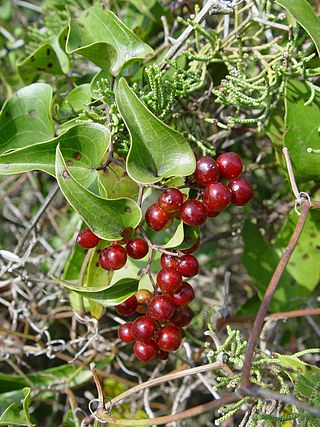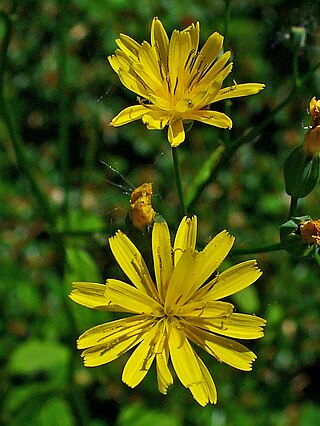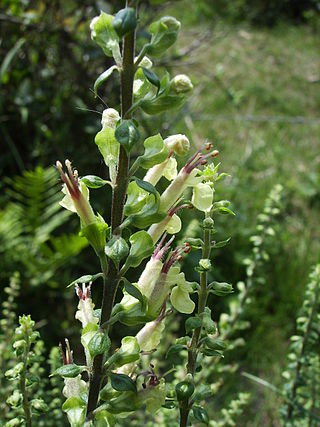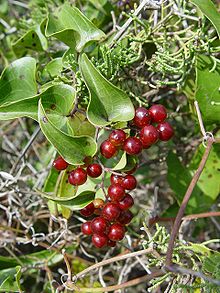
Smilacaceae, the greenbriers, is a family of flowering plants. While they were often assigned to a more broadly defined family Liliaceae, most recent botanists have accepted the two as distinct families, diverging around 55 million years ago during the Early Paleogene. One characteristic that distinguishes Smilacaceae from most of the other members of the Liliaceae-like Liliales is that it has true vessels in its conducting tissue. Another is that the veins of the leaves, between major veins, are reticulate (net-shaped), rather than parallel as in most monocots.

Smilax is a genus of about 300–350 species, found in the tropics and subtropics worldwide. They are climbing flowering plants, many of which are woody and/or thorny, in the monocotyledon family Smilacaceae, native throughout the tropical and subtropical regions of the world. Common names include catbriers, greenbriers, prickly-ivys and smilaxes. Sarsaparilla is a name used specifically for the Neotropical S. ornata as well as a catch-all term in particular for American species. Occasionally, the non-woody species such as the smooth herbaceous greenbrier are separated as genus Nemexia; they are commonly known by the rather ambiguous name carrion flowers.

Lapsana communis, the common nipplewort, is a species of flowering plant in the family Asteraceae. It is native to Europe and southwestern Asia. and widely naturalized in other regions including North America.

Smilax rotundifolia, also known as roundleaf greenbrier or common greenbrier, is a woody vine native to the southeastern and eastern United States and eastern Canada. It is a common and conspicuous part of the natural forest ecosystems in much of its native range. The leaves are glossy green, petioled, alternate, and circular to heart-shaped. They are generally 5–13 cm long. Common greenbrier climbs other plants using green tendrils growing out of the petioles.

Salpichroa origanifolia is a species of flowering plant in the nightshade family known by the common names lily of the valley vine, pampas lily-of-the-valley or cock's-eggs.

Teucrium scorodonia, common name the woodland germander or wood sage, is a species of flowering plant in the genus Teucrium of the family Lamiaceae. It is native to Western Europe and Tunisia, but cultivated in many places as an ornamental plant in gardens, and naturalized in several regions.

Sagina subulata, the heath pearlwort, Irish-moss, awl-leaf pearlwort or Scottish moss, is a species of flowering plant in the pink and carnation family Caryophyllaceae. It is native to Europe, from Iceland south to Spain, and east to southern Sweden and Romania. It occurs on dry sandy or gravelly soils.

Calystegia silvatica is the largest species of bindweed and is a strong rampant climber. It is native to southern Europe but has been introduced to many other areas because it is an attractive garden plant. Calystegia silvatica subsp. fraterniflora(Mack. & Bush) Brummitt is native to North America.

Anthyllis vulneraria, the common kidneyvetch, kidney vetch or woundwort is a medicinal plant native to Europe. The name vulneraria means "wound healer".

Convolvulus althaeoides is a species of morning glory known by the common names mallow bindweed and mallow-leaved bindweed. This flowering plant is native to the Mediterranean Basin, but it is occasionally seen in other areas of similar climate, such as California in the United States, where it has been introduced. This is a climbing perennial plant with solitary flowers on long peduncles. The flower is a funnel-shaped pink bloom three or four centimeters wide. The leaves are deeply divided into narrow, fingerlike lobes.

Smilax glauca, the cat greenbriar or catbriar is a woody vine in the family Smilacaceae. It is native to central and eastern portions of the United States as well as Mexico, where it is a common and conspicuous part of the forest vegetation.

Solidago rugosa, commonly called the wrinkleleaf goldenrod or rough-stemmed goldenrod, is a species of flowering plant in the family Asteraceae. It is native to North America, where it is widespread across eastern and central Canada and the eastern and central United States. It is usually found in wet to mesic habitats.

Potentilla norvegica is a species of cinquefoil known by the common names rough cinquefoil, ternate-leaved cinquefoil, and Norwegian cinquefoil. It is native to Europe, Asia, and parts of North America, and it can be found elsewhere as an introduced species.

Spergularia media is a species of flowering plant in the family Caryophyllaceae known by the common names media sandspurry and greater sea-spurrey. It is native to Eurasia and the Mediterranean, where it grows in many types of habitat, including disturbed areas, including places with saline substrates, such as salt marshes and beaches. It is known in many other parts of the world as an introduced species and a common roadside weed. In North America it is a "highway halophyte", often springing up at the margins of roads that are heavily salted in the winter.

Achyranthes aspera is a species of plant in the family Amaranthaceae. It is distributed throughout the tropical world. It can be found in many places growing as an introduced species and a common weed. It is an invasive species in some areas, including many Pacific Islands environments.

Asparagus acutifolius, common name wild asparagus, is an evergreen perennial plant belonging to the genus Asparagus. The specific epithet, acutifolius, meaning "thorny leaves", is derived from Latin acutus, and -folius (-leaved), and refers to the characteristic shape of the leaves, a quite common feature in the typical plants of the Mediterranean.

Stachys recta, commonly known as stiff hedgenettle or perennial yellow-woundwort, is herbaceous perennial plant of the family Lamiaceae.

Iberis umbellata, common name garden candytuft or globe candytuft, is a herbaceous annual flowering plant of the genus Iberis and the family Brassicaceae.

Rhamnus alaternus is a species of flowering plant in the buckthorn family Rhamnaceae, known by the common names Italian buckthorn or Mediterranean buckthorn. It is a hardy medium-sized evergreen shrub with fragrant flowers.

Smilax laurifolia is a species of flowering plant in the greenbrier family known by the common names laurel greenbrier, laurelleaf greenbrier, bamboo vine, and blaspheme vine. It is native to the southeastern United States, where it occurs along the Gulf and Atlantic coastal plains from Texas to New Jersey, the range extending inland to Arkansas, Oklahoma, and Tennessee. It also occurs in Cuba and the Bahamas.

























